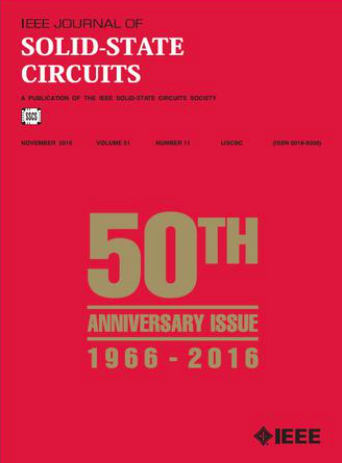A Cryo-CMOS Controller With Class-DE Driver and DC Magnetic-Field Tuning for Quantum Computers Based on Color Centers in Diamond
IF 4.6
1区 工程技术
Q1 ENGINEERING, ELECTRICAL & ELECTRONIC
引用次数: 0
Abstract
Striving toward a scalable quantum processor, this article presents the first cryo-CMOS quantum bit (qubit) controller targeting color centers in diamond. Color-center qubits enable a modular architecture that allows for the 3-D integration of photonics, cryo-CMOS control electronics, and qubits in the same package. However, performing quantum operations in a scalable manner requires large currents in the driving coils due to low coil-to-qubit coupling. Moreover, active calibration of the qubit Larmor frequency is required to compensate inhomogeneities of the bias magnetic field. To overcome these challenges, this work proposes both a cryo-CMOS alternating current (AC) controller consisting of a class-DE series-resonant driver and a DC current regulator (DC CR) that uses a triode-biased H-bridge for scalable low-power qubit operations. By experimentally validating the cryo-CMOS performance with a nitrogen-vacancy (NV) color-center qubit, the AC controller can drive a Rabi oscillation up to 2.5 MHz with a supply draw of 6.5 mA, and the DC CR can tune the Larmor frequency by ±9 MHz while driving up to ±20 mA in the bias coil.为基于金刚石色彩中心的量子计算机设计的带 DE 类驱动器和直流磁场调谐功能的低温 CMOS 控制器
为了实现可扩展的量子处理器,本文介绍了首个针对金刚石色彩中心的低温-CMOS 量子位(量子位)控制器。色彩中心量子比特采用模块化架构,可将光子学、低温-CMOS 控制电子器件和量子比特三维集成在同一封装中。然而,由于线圈与量子比特之间的耦合度较低,以可扩展的方式执行量子操作需要在驱动线圈中注入大电流。此外,还需要主动校准量子比特的拉莫尔频率,以补偿偏置磁场的不均匀性。为了克服这些挑战,这项研究提出了一种低温-CMOS 交流电(AC)控制器,该控制器由一个 DE 类串联谐振驱动器和一个直流电流调节器(DC CR)组成,后者使用一个三极管偏置 H 桥,用于可扩展的低功耗量子比特操作。通过使用氮空位(NV)色心量子比特对低温-CMOS 性能进行实验验证,交流控制器可以驱动高达 2.5 MHz 的拉比振荡,耗电仅为 6.5 mA,而直流电流调节器可以将拉莫尔频率调整为 ±9 MHz,同时在偏置线圈中驱动高达 ±20 mA 的电流。 利用拉姆齐实验和栅极层析成像(GST),低温-CMOS 控制的 $T_{2}^{*}$ 相干时间可达 5.3~\mu $ s,单量子比特栅极保真度超过 98%。这些结果证明了所提出的低温-CMOS 芯片的功效,并使基于色彩中心的模块化量子处理器的开发成为可能。
本文章由计算机程序翻译,如有差异,请以英文原文为准。
求助全文
约1分钟内获得全文
求助全文
来源期刊

IEEE Journal of Solid-state Circuits
工程技术-工程:电子与电气
CiteScore
11.00
自引率
20.40%
发文量
351
审稿时长
3-6 weeks
期刊介绍:
The IEEE Journal of Solid-State Circuits publishes papers each month in the broad area of solid-state circuits with particular emphasis on transistor-level design of integrated circuits. It also provides coverage of topics such as circuits modeling, technology, systems design, layout, and testing that relate directly to IC design. Integrated circuits and VLSI are of principal interest; material related to discrete circuit design is seldom published. Experimental verification is strongly encouraged.
 求助内容:
求助内容: 应助结果提醒方式:
应助结果提醒方式:


